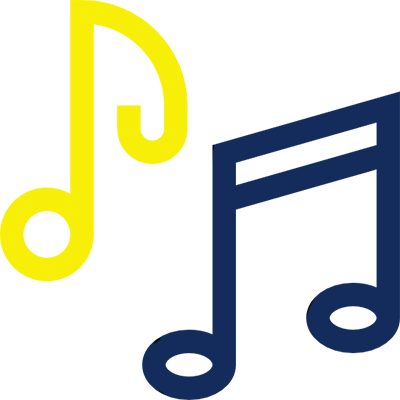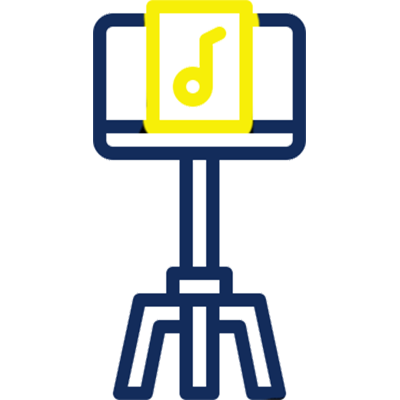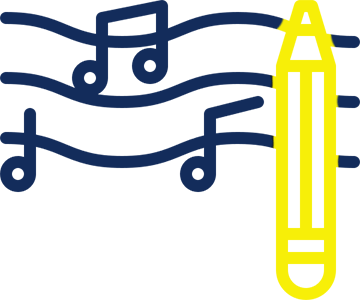Certificate in Music Production
Certificate in
Music Production
Best Music Production Courses in Mumbai 2024
Eligibility Criteria
- Minimum Age: 16 years and above
- Educational Background: High school or equivalent (basic understanding of music is beneficial but not mandatory)
- Passion for Music: Genuine interest in music production and creativity in music composition.
- Basic Computer Skills: Familiarity with using computers and basic software.
- Access to Music Production Tools: Students should ideally have access to a laptop/computer with a DAW
- Language Proficiency: Basic proficiency in English and Hindi is preferred, as course materials and instruction are primarily in English and Hindi.
- Minimum Age: 16 years and above
- Educational Background: High school or equivalent (basic understanding of music is beneficial but not mandatory)
- Passion for Music: Genuine interest in music production and creativity in music composition.
- Basic Computer Skills: Familiarity with using computers and basic software.
- Access to Music Production Tools: Students should ideally have access to a laptop/computer with a DAW
- Language Proficiency: Basic proficiency in English and Hindi is preferred, as course materials and instruction are primarily in English and Hindi.
Course Curriculum
Module – 1
- All the Major & Minor scale
- Harmony/ Chords/Triads and Types
- Inversion of Chords and their Use
- Relative Major and Minor Scale
- Family of Chords
- Harmonic/Chord Progression
- Ear training
- Compass of instruments
Module – 2
- Time Signature
- Working with melodies and countermelodies
- Harmonisation
- Voicing
- Using Pedal Point,Altered Bass Chords,Chord Leading Rules,Chords Substitution.
- Overview of Logic Pro X , Ableton Live
- Tools, Channel Strips,Vst & Effect Plugins
- Quantise Midi notes and Flex Audio
- Midi Editor,Midi Transform and trigger Midi from Logic
- Vocal tuning using Flex,Wavetuner,Auto Tuner
- Recording, Punch in Recording, Multi track recording audio track
- Automation Audio & Midi
- Understanding and working with the Busses
- Summing & Routing with the Busses
- Vocoder and Vocal Production
- Understanding Compressor,Reverb, Delay, Equaliser
- Side chain techniques single and overall track
- Melodyne
- Understanding the Concept of Sampler
- Use of Different Sample
- Project Alternatives,Metadata
- Real Time & Offline Bouncing,Sample rate,Bitrate
- Understanding the Score Editor
- Parallel Compression,Reverb & Delay Techniques.
- Customising workflow and hotkeys for efficiency
- Basics of MIDI and how it functions within a DAW
Working with virtual instruments and plugins (VSTs)
MIDI controllers and their uses
- Creating melodies, harmonies and drum patterns using MIDI
- Quantization, velocity adjustments, and humanizing MIDI performances
Basics of recording audio
- Microphone types, placement, and use cases
- Recording environments: Home studio vs professional studio
- Working with audio interfaces for clean signal flow
a). Introduction to Song Structure
- Understanding common song forms (e.g., Verse-Chorus, AABA, ABABCB).
- Differentiating between intro, verse, chorus, bridge, breakdown, outro, etc.
- Analyzing song structure in various genres (pop, EDM, hip-hop, film score, etc.).
b). Dynamic Arrangements
- How to create tension and release in a track.
- Building energy through progressive layering.
- Using silence and breakdowns for contrast.
c). Instrumental Layering
- Layering instruments effectively for depth and texture.
- Balancing frequencies between instruments to avoid clutter.
- Techniques for arranging leads, pads, and supporting instruments.
d). Using Automation for Arrangements
- Automating volume, panning, effects, and filters for smooth transitions.
- Dynamic build-ups using automation (e.g., risers, filter sweeps).
e). Vocal Arrangement
- Arranging lead vocals, harmonies, and backing vocals.
- Layering vocals for impact in different song sections.
- Using vocal chops as arrangement elements.
f). Using FX and Ambience in Arrangements
- Arranging effects like reverb, delay, and echoes to fill space.
- Creating atmospheric textures to enhance sections.
- The role of background sounds in building a full arrangement.
g). Arrangement Workflow and Industry Techniques
- Best practices for organizing your DAW project for efficient arrangements.
- Workflow techniques for rapid prototyping and arranging.
- Using markers, templates, and grouping in DAWs.
VIVAs : Interactive sessions where students will discuss their projects and demonstrate their understanding of key concepts.
Project Submissions: Students are required to submit projects that reflect their learning and skills gained throughout the course.
Assignments: Regular assignments will be evaluated to gauge ongoing progress and understanding of course material.
Course Curriculum
Module – 1
- All the Major & Minor scale
- Harmony/ Chords/Triads and Types
- Inversion of Chords and their Use
- Relative Major and Minor Scale
- Family of Chords
- Harmonic/Chord Progression
- Ear training
- Compass of instruments
Module – 2
- Time Signature
- Working with melodies and countermelodies
- Harmonisation
- Voicing
- Using Pedal Point,Altered Bass Chords,Chord Leading Rules,Chords Substitution.
- Overview of Logic Pro X , Ableton Live
- Tools, Channel Strips,Vst & Effect Plugins
- Quantise Midi notes and Flex Audio
- Midi Editor,Midi Transform and trigger Midi from Logic
- Vocal tuning using Flex,Wavetuner,Auto Tuner
- Recording, Punch in Recording, Multi track recording audio track
- Automation Audio & Midi
- Understanding and working with the Busses
- Summing & Routing with the Busses
- Vocoder and Vocal Production
- Understanding Compressor,Reverb, Delay, Equaliser
- Side chain techniques single and overall track
- Melodyne
- Understanding the Concept of Sampler
- Use of Different Sample
- Project Alternatives,Metadata
- Real Time & Offline Bouncing,Sample rate,Bitrate
- Understanding the Score Editor
- Parallel Compression,Reverb & Delay Techniques.
- Customising workflow and hotkeys for efficiency
- Basics of MIDI and how it functions within a DAW
Working with virtual instruments and plugins (VSTs)
MIDI controllers and their uses
- Creating melodies, harmonies and drum patterns using MIDI
- Quantization, velocity adjustments, and humanizing MIDI performances
Basics of recording audio
- Microphone types, placement, and use cases
- Recording environments: Home studio vs professional studio
- Working with audio interfaces for clean signal flow
a). Introduction to Song Structure
- Understanding common song forms (e.g., Verse-Chorus, AABA, ABABCB).
- Differentiating between intro, verse, chorus, bridge, breakdown, outro, etc.
- Analyzing song structure in various genres (pop, EDM, hip-hop, film score, etc.).
b). Dynamic Arrangements
- How to create tension and release in a track.
- Building energy through progressive layering.
- Using silence and breakdowns for contrast.
c). Instrumental Layering
- Layering instruments effectively for depth and texture.
- Balancing frequencies between instruments to avoid clutter.
- Techniques for arranging leads, pads, and supporting instruments.
d). Using Automation for Arrangements
- Automating volume, panning, effects, and filters for smooth transitions.
- Dynamic build-ups using automation (e.g., risers, filter sweeps).
e). Vocal Arrangement
- Arranging lead vocals, harmonies, and backing vocals.
- Layering vocals for impact in different song sections.
- Using vocal chops as arrangement elements.
f). Using FX and Ambience in Arrangements
- Arranging effects like reverb, delay, and echoes to fill space.
- Creating atmospheric textures to enhance sections.
- The role of background sounds in building a full arrangement.
g). Arrangement Workflow and Industry Techniques
- Best practices for organizing your DAW project for efficient arrangements.
- Workflow techniques for rapid prototyping and arranging.
- Using markers, templates, and grouping in DAWs.
VIVAs : Interactive sessions where students will discuss their projects and demonstrate their understanding of key concepts.
Project Submissions: Students are required to submit projects that reflect their learning and skills gained throughout the course.
Assignments: Regular assignments will be evaluated to gauge ongoing progress and understanding of course material.
Career Opportunities in Music production
Upon completion of the Certification in Music Production, students will be prepared for several exciting roles within the music industry, including :
Career Opportunities in Music production
Music Director
Music Producer
Composer
Arranger
Sound Designer
Music Programmer
Music Supervisor
Session Artist
Educator
Frequently Asked Questions
No, prior experience is not required. The course is designed to teach beginners the essentials of music production.
We recommend using DAWs such as Logic Pro,Ableton Live, Cubase or Studio One.However, you can use any DAW you’re comfortable with.
Yes, students who successfully complete the course will be awarded a certification in Music Production.
Yes, we offer flexible payment options with installment plans.
Yes, students will have access to our professional studios for practice and project work.
We provide internships and placement opportunities for Studios,Production houses and freelance projects for Films,OTT platforms,Television shows, Radio industry,etc.



